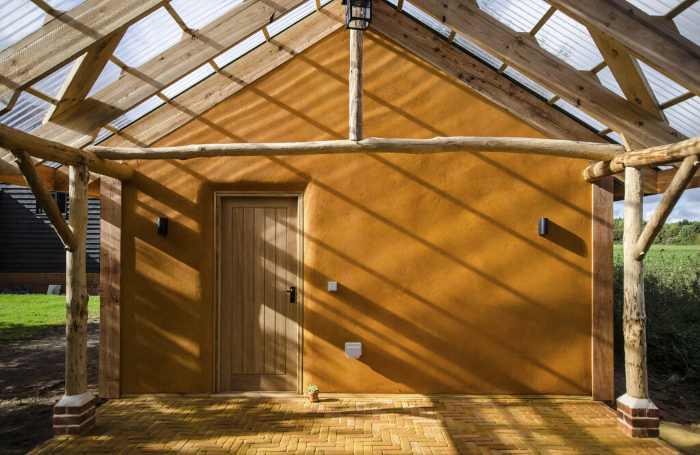Natural, organic and plant-based building materials can provide great solutions for low-energy, sustainable construction.
But their use is too often dismissed out of hand based on unwarranted presumptions: that they might be unfamiliar to a builder, too much effort to source or only appropriate to rural contexts. These objections are increasingly outdated, as more practices and contractors adopt, or rediscover, them; and more suppliers create products from them that are easy to use.
Grain Architecture is an emerging practice that uses natural, low-carbon materials almost exclusively, yet its output is certainly not confined to rural archetypes. Its portfolio includes low energy extensions, new builds and retrofits that all stay true to its natural-first philosophy; including an urban terrace of elegant townhouses that will still be delivered with all natural construction materials.
Founding director Janna Laan Lomas will be explaining how natural materials can enhance wellbeing and health at next week’s online conference RIBA Guerrilla Tactics: Stop, Collaborate and Listen, on Tuesday 9 November. Her work shows that an ever-widening range of natural materials is now available, many pre-fabricated for ease of use.
There are few constraints on what can be built with them. One of Grain’s current projects using natural materials is an energy efficient deep retrofit of a 1970s semi-detached house. It will be naturally insulated, wrapped in a wood fibre board and lime rendered.
The latter materials are good examples of one of the advantages natural materials provide: breathability. This actually refers to movement of moisture, not of air. It is a quality that allows a building to self-regulate its humidity levels, which ultimately provides occupants with better air quality.
Timber is probably the most familiar natural building material for most architects.
“Sweet chestnut and larch are two examples of relatively underused British woods,” Lomas points out. “These can work well as either cladding or timber frame”.
But there is a wealth of other natural products that Grain have made use of:
Structural pre-fabricated straw panels for walls
These can be wrapped with wood fibre board and finished with lime render or cladding. EcoCocon is one example, though there are other suppliers.
Loadbearing, compressed straw bales
This is a low-tech material very popular with self-builders. The walls are compressed using straps after construction. Straw Works is one of several suppliers.
Pre-fabricated wood fibre filled panels
All-natural panels can be used for floors, walls and roofs; while walls can be externally wrapped in wood fibre board for insulation. Kithurst Homes is one supplier, but other companies offer similar products.
Timber studs in timber frames and floors
These can be filled with a variety of natural insulation materials such as flexible wood fibre, sheep’s wool, hemp fibre or recycled cotton (cellulose).

Earth blocks
Unfired earth blocks, such as ‘cob’ or ‘adobe’, can be used for walls. They are available from a variety of suppliers, often for repair purposes, but Grain has used them on new build projects. The external face could be wrapped with cork blocks, for example, and then lime rendered.
Rammed earth
An increasingly well known earth building technique, rammed earth can provide an alternative to a concrete slab floor. It can be used on top of compacted aggregate foundations to minimise or avoid the use of cement.
Hempcrete
This is made from the woody ‘shivs’ of the hemp plant, with lime added. It can be wet cast in situ and is also available as pre-dried blocks. This can also be finished with lime render externally or internally. Hempcrete is not in itself structural, so would be used within a timber frame.
Internal insulation for walls
There are many natural materials that can be used for internal insulation, such as wood fibre board, hempcrete or corkboard. Internal walls can then be finished with a breathable lime plaster.
Lomas would leave cavities unfilled as any condensation will then form on the external wall, being the coldest, where it can dry out; and so avoid damp problems.
External insulation for walls
As the internal leaf of the cavity wall is the warm side, there is less likelihood of condensation forming; Lomas would fill the cavity. The external wall could have timber stud work infilled with a natural insulation such as wood fibreboard and be finished with breathable lime render.
Supply chains have now developed to the extent that most of the above are no longer the preserve of fringe enthusiasts. There is an ever-widening range of natural materials from established suppliers that can tackle most projects.
Thanks to Janna Laan Lomas, Director, Grain Architecture.
Janna Laan Lomas will explain how natural materials can enhance wellbeing and health at the online conference RIBA Guerrilla Tactics: Stop, Collaborate and Listen, on Tuesday 9 November. Tickets are available now.
Text by Neal Morris. This is a Professional Feature edited by the RIBA Practice team. Send us your feedback and ideas
RIBA Core Curriculum topic: Sustainable architecture.
As part of the flexible RIBA CPD programme, professional features count as microlearning. See further information on the updated RIBA CPD core curriculum and on fulfilling your CPD requirements as an RIBA Chartered Member.
First published Thursday 4 November 2021









